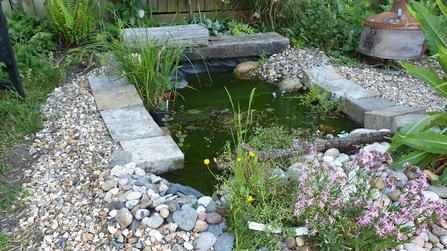
Blackbird in nest box. Photo by Amy Lewis
A few well-chosen plants transform Ed's front garden

Blackbird in nest box. Photo by Amy Lewis
A nest is an amazing feat of engineering made by the bird just using its beak! Help your garden birds by creating a nesting bundle made from straw, moss, dry grass, feathers, down from old pillows, coir fibre from old door mats, short scraps of wool and string, and untreated shed hair from pets - due to nestlings being very sensitive to chemicals.
Avoid human hair as it is too thin and can tangle around tiny legs and block circulation.
Make a fluffy heap of materials and wrap them round a forked stick about a foot long. Wind wool or twine around it to hold everything in place and add more layers. Then hang up the nesting bundle in a tree and watch the birds pick their favourites!
How to make a nesting stocking (https://youtu.be/bGdSAvO7fHI)
Family activity - How to make a nesting stocking

When pollinators emerge from the long winter hibernation, food is generally scarce and early blossoms not readily available. Keep those dandelions, daisies, clover, shiny crane’s bill, and other flowering 'weeds' for the early queens, who will be hungrily scouring around for food and suitable nesting places.
Plant up a pot of native wild primroses, hellebores and lungwort - all flowering plants of early spring to give your garden bees a head start with life-giving nectar.
A hedgehog eating pet food left out in a garden. Picture: Gillian Day
Hedgehogs are waking up and hunting for food. Did you know they can travel several miles a night looking for beetles and other crunchy critters! Welcome hedgehogs into your garden by making a small CD-sized hole at the base of your garden fence or hedge.
Put out a shallow dish of saucer of water and meat-based wet dog or cat foods, or dry cat/kitten food to give your hungry hogs a spring treat. Supplementary food is often crucial for the survival of these endangered mammals, especially when natural food is scarce, but a few things to remember:
To keep food dry, make a simple feeding station by using an upturned storage box with a CD-sized opening for access.

A pond is one of the best things you can add to a garden for wildlife
Ponds are an important feature in any wildlife garden, and any size will do. Even a washing up bowl or Belfast sink is enough to encourage for wildlife into your garden.
Make sure you always include an escape ramp for its inhabitants, running parallel and close to its sides, so that creatures can get out of the pond easily if needed.
Get some more tips about creating a garden pond in this short video from Ben.
Build a garden pond (https://youtu.be/NPwEvxYhfSg)
Create a wildlife pond